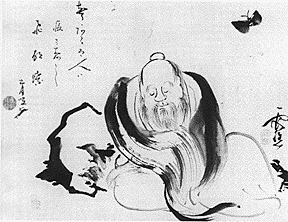When it comes to Taoist sages, Chuang Tzu is my favorite. I like him better than Lao Tzu. Both sages have similarities; both may have lived at around the same time, for example (Chuang Tzu lived during the 4th century BC, and so may have Lao Tzu), and both sages wrote texts of Taoist wisdom. But for me, what sets Chuang Tzu apart is the way he chose to convey that wisdom.
Let me start by saying that I think the Tao te Ching is a good book, and I enjoy it very much. However, it is written like a list of the ways one should think and behave in order to be “one with the Tao.” Chuang Tzu’s book (self-titled), on the other hand, is a book of stories, that still manages to get across the same Taoist teachings, and I prefer stories to lists.
Each story is usually short, usually funny, and full of teachings on how to live more naturally with the Tao. Consider this example, one of my favorite of his stories, entitled The Owl and the Phoenix:
Hui Tzu was prime minister of Liang
He had what he believed to be inside information
That Chuang Tzu coveted his post,
And was plotting to supplant him.
When Chuang Tzu came to visit Liang,
The prime minister send out police to arrest him,
But although they searched for three days and nights,
They could not find him.
Meanwhile Chuang Tzu presented himself
to Hui Tzu of his own accord, and said:
“Have you heard about the bird
that lives in the south –
the phoenix that never grows old?
“This undying phoenix rises out of the south sea
and flies to the sea of the north:,
never alighting except on certain sacred trees.
He will touch no food
but the most exquisite rare fruit,
And he drinks only from the clearest springs.
“Once an owl
chewing an already half decayed rat
saw the phoenix fly over.“Looking up he screeched with alarm
and clutched the dead rat to himself
in fear and dismay.
“Prime minister,
why are you so frantic,
clinging to your ministry
and screeching at me in dismay?”
(http://www.osholeela.com/poetry/chuangtzu/cz6.html)
Funny, right? This story perfectly illustrates a section of chapter 46 of the Tao te Ching:
There is no calamity like not knowing what is enough.
There is no evil like covetousness.
Only he who knows what is enough will always have enough.
Both this section and The Owl and the Phoenix illustrate the same concept, and Chuang Tzu’s story does it while also being funny and entertaining. Here’s another one called The Turtle:
Chuang Tzu with his bamboo pole
was fishing in the Pu river.
The prince of Chu sent two vice-chancellors
with a formal document:
We hereby appoint you prime minister.
Chuang Tzu held his bamboo pole still.
Watching the Pu river, he said:
“I am told there is a sacred tortoise offered
and canonized three thousand years ago,
venerated by the prince, wrapped in silk,
in a precious shrine on an altar in the temple.
What do you think?
Is it better to give up one’s life
and leave a sacred shell
as an object of cult
in a cloud of incense
for three thousand years,
or to live as a plain turtle
dragging its tail in the mud?”
“For the turtle”, said the vice-chancellor,
“better to live and drag its tail in the mud!”
“Go home!”, said Chuang Tzu.
“Leave me here
to drag my tail in the mud.”
(http://www.osholeela.com/poetry/chuangtzu/)
This story illustrates Taoism in a broader sense; that living simply and naturally makes for a healthier, happier life. As a final example of Chuang Tzu’s work, here’s an extremely well-known example that many may not know should be attributed to him:
“Once upon a time, I dreamt I was a butterfly, fluttering hither and thither, to all intents and purposes a butterfly. I was conscious only of my happiness as a butterfly, unaware that I was myself. Soon I awaked, and there I was, veritably myself again. Now I do not know whether I was then a man dreaming I was a butterfly, or whether I am now a butterfly, dreaming I am a man.”
All in all I think, although Lao Tzu put down the foundation for Taoism, Chuang Tzu is really the one who took it and built it up into something dynamic. His stories go beyond telling one how to live in the Tao, to illustrating what that would actually look like if practiced, and still (in my opinion) come off being funny instead of overly preachy.

